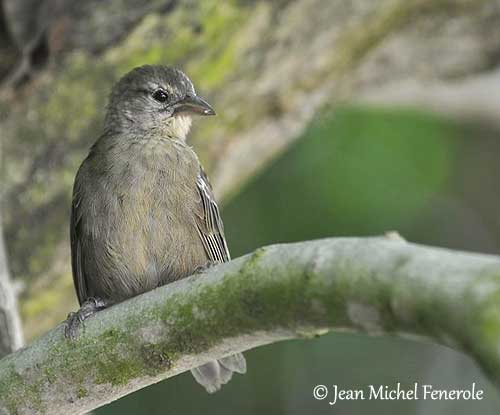
Fr: Foudi des Seychelles
Ang: Seychelles Fody
All: Seychellenweber
Esp: Fodi de Seychelles
Ita: Fody delle Seychelles
Nd: Seychellenwever
Sd: seychellfody
Photographer:
Jean Michel Fenerole
Photos d’Oiseaux du monde
Text by Nicole Bouglouan
Sources:
HANDBOOK OF THE BIRDS OF THE WORLD Vol 15 by Josep del Hoyo-Andrew Elliot-David Christie - Lynx Edicions – ISBN: 9788496553682
Birds of Seychelles – By Adrian Skerrett and Tony Disley – Editeur: A&C Black, 2013 – ISBN: 140818124X, 9781408181249 – 176 pages
Birds of Madagascar and the Indian Ocean Islands Par Roger Safford, Adrian Skerrett, Frank Hawkins – ISBN: 1472924118, 9781472924117- Editeur: Bloomsbury Publishing, 2015
HBW Alive
Wikipedia, the free encyclopaedia
Aqua-Firma – Water – Wilderness – Wildlife
Observations on the breeding biology of the Seychelles Fody on Cousine Island
Family Ploceidae
Page Passeriforme Order
Seychelles Fody
Foudia sechellarum
Passeriformes Order – Ploceidae Family
INTRODUCTION:
The Seychelles Fody is endemic to the Seychelles where it frequents plantations and woodland. It occurs on several islands after introduction and reintroduction on some islands for conservation of the species.
It has fairly dull plumage, but it is extremely vocal and often conspicuous when feeding on the ground around houses in small groups.
The Seychelles Fody has very restricted range and small population, although several introductions have caused the continuous increase of the numbers. But currently, it is still listed as Near Threatened.
DESCRIPTION OF THE BIRD:
Biometrics:
Length: 12 cm
Weight: 15-19 g
The Seychelles Fody adult male in breeding plumage is olive-green above and paler below.
Mantle and back show dark central streaks to feathers, whereas upperwings and tail are olive-green. The flight-feathers are edged pale yellowish.
The underparts are pale olive-grey.
On the head, the male has dull yellow forehead, central crown, chin and throat, whereas cheeks and ear-coverts are olive-grey. The nape is olive-green.
The robust bill is black. The eyes are dark brown. Legs and feet are brown.
Non-breeding male and adult female have olive-brown forehead and crown. Chin and throat are pale buff. The bill is paler.
The juvenile resembles female, but the wing-coverts have buffy edges. The plumage is more uniform overall. The bill is pale brown.

RANGE:
The Seychelles Fody is found on Cousin, Cousine and Frégate Islands. The species has been reintroduced to Aride Island in the Seychelles. It has been introduced on D’Arros (Amirante Islands) and Denis.
HABITAT:
The Seychelles Fody usually frequents woodlands. However, the species is now more adapted to other habitat types such as coconut plantations and gardens.
CALLS AND SONGS: SOUNDS BY XENO-CANTO
The Seychelles Fody is locally named « toktok », derived from the typical « tok-tok-tok » calls. These notes are given more rapidly when the bird is alarmed, and a higher alarm call “tchr” can be heard too. While foraging and feeding in groups, the birds give a single “tok” interspersed with long pauses.
Both sexes sing, but mainly the male. The song includes single high-pitched notes interspersed with pauses becoming shorter and involving series of almost continuous high notes.
BEHAVIOUR IN THE WILD:
The Seychelles Fody feeds primarily on insects, spiders and small arthropods. It also consumes fruit, nectar and seeds. Insect diet includes bugs, beetles and ants caught by gleaning from the vegetation.
It may sometimes take eggs of seabirds, and especially White Tern eggs. This tern is known for laying its single egg directly on the bare branch. The fody tips the egg from its branch onto the ground to break it and then, to eat it.
It can be seen in groups feeding on the ground around houses while calling. They constantly flick their wings.
The Seychelles Fody is socially monogamous and both mates share the nesting duties. They defend the territory throughout the year.
From some observations, male’s displays are described by “upright wing-beating” in front of the female. She responds by crouching along the branch while facing the male, with her bill opened and pointed upwards.
However, copulation solicitation shows the female spreading her wings and facing away from the male. But these displays are still unclear.
The Seychelles Fody is resident.
It has direct flight during which the bird appears compact and almost tailless.

REPRODUCTION OF THIS SPECIES:
The Seychelles Fody is known to hybridize with the Red Fody. The hybrids resemble Seychelles Fody but with bright red, orange or yellow head. They have sometimes a black band through the eye.
The breeding season occurs between May and September. As a monogamous species, both mates remain together during several following seasons. Some behaviour may indicate sometimes possible co-operative breeding system.
The bulky nest is built by both mates, but mainly by the male. This is a domed structure with a side entrance. It is made with palm fibres, grass, twigs and tendrils. Only the nest-chamber is lined. This nest is not suspended but supported by twigs. It is placed in tree, between 2 and 25 metres above the ground.
The female lays 1-2 white eggs and incubates alone during two weeks. Both adults feed the young by regurgitation and then with insects given in the bill. Both parents share the brood, with male caring the young male and female with the young female. If there is only one fledgling, the female cares it alone. The post-fledging parental care lasts about 3 months.
The introduced Common Myna may take fody’s eggs.
PROTECTION / THREATS / STATUS:
The Seychelles Fody is restricted to some islands in Seychelles archipelago. The decline of population was caused by habitat loss and persecution by humans, because this species was considered a crop pest. But now, competition and predation from introduced species such as cats and rats are an important threat.
The global population is estimated to number 3,500 individuals, equating to 2,300 mature individuals. It is slowly increasing but continuously, thanks to introductions and reintroductions.
But currently, the Seychelles Fody is listed as Near Threatened.